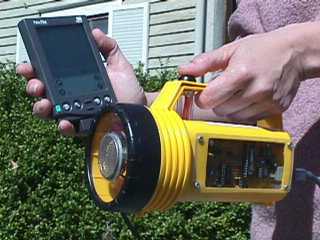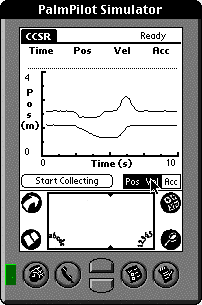Hardware Interface Specifications
CCSR Software for the Palm Pilot
Palm CCSR v1.0b4 is available
The Palm Pilot is pictured below connected to the CCSR ready to take data. There is no seperate interface box, the interface is built directly into the CCSR and communicates to the Palm Pilot via an RS-232 serial interface. This portability makes the CCSR suitable for investigations outside a traditional lab.

The CCSR operating with a Palm Pilot
Pictured below is a screenshot of the alpha CCSR software running on a Palm Pilot
simulator. The lower trace on the graph is distance, the upper trace velocity.

Palm Pilot CCSR Software
In the graph above the CCSR was held steady, then moved slowly towards the ceiling,
stopped, moved quickly away, and again held steady.
Downloading the Palm CCSR software
Version 1.0b4 of the CCSR software for a Palm computer is available here in binhex format for a Mac or zip format for a PC. After downloading you will need to install it on a Palm computer. It has been tested on thePalm Professional and the Palm III.
CCSR Macintosh Simulator
A version of the CCSR software is also available that runs on the Mac and simulates the Palm computer and interface. This is useful for demoing the software because the Palm screen image can be projected from the Macintosh screen. The software will work with the CCSR if a Macintosh serial cable is available. Here's a 723K compressed archive of the CCSR Mac simulator in binhex format.
CCSR Source Code
The CCSR Palm software has been developed by the CILT project under the standard CILT intellectual proerty agreements which means the code is in the public domain. If you would like to view or use the code please contact Stephen Bannasch <stephen@concord.org>.